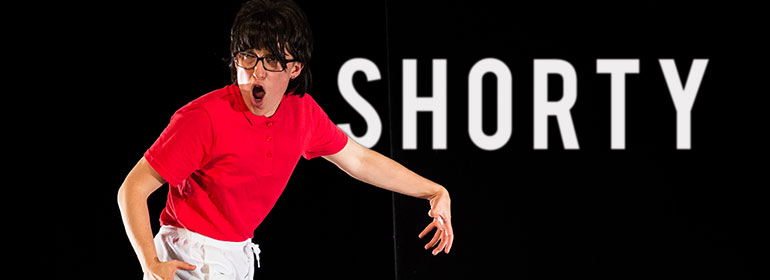Hester Chillingworth is bringing Shorty, a drag-child, to the Project Arts Centre as part of Live Collision
Hester Chillingworth will perform ‘Shorty’ as part of performance art festival Live Collision in the Project Arts Centre, Cube tomorrow, Thursday April 20 at 8pm.
Here’s a little taste of what to expect from the performance:
Your child could do better.
A little less chatter and experimentation would improve things enormously.
As would standing in the right line and using the right loos.
Your child has the potential to be an asset to the group but needs to learn to put things away and seems not to understand the consequences of failure.
Your child is like a cheap rubber ball – neither here nor there, neither this nor that, hard to control and causing problems, blurring lines and asking difficult bloody questions.
Please see me.
In the run up to the show, we caught up with Chillingworth to ask a few questions.
1. Explain the premise of Shorty in a couple of sentences.
Shorty is a deconstructed drag-child, who frays at the edges and plays at the edges.
This show champions the not-quite, the slight and the awkward. It’s about the importance of grey areas. And what’s in your packed lunch.
2. What is the inspiration for your character Shorty?
Shorty came about because I’d been thinking for a long time about developing a drag king character, but there was always, for me, something slightly unsatisfactory about the idea of heading towards a generic sort of ‘manliness’ – it wasn’t what I felt I needed to be doing in order to open up a new space in which to think performatively about gender.
I was most interested in creating a drag character that was heading towards no gender explicitly, but I couldn’t think quite what this would look like that’s any different from me in the real world!
I have a huge respect for children and the way they deal with the daunting confusion of life, and it was when I started thinking about childhood itself as an essentially queer space that the possibility of creating a drag child occurred to me.
3. What do you think about drag performance in general nowadays?
The drag I see tends to be pretty radical and subversive drag, and I love it. Drag is a subculture with its own history and community and I’m not in a position to comment in any sweeping way on the whole of that.
What I can say is that the drag that excites me the most is drag which is unexpected and works in some way to reconfigure and widen our understanding of the possibilities of gender.
4. What do you feel are the biggest challenges facing non-binary children and adults today?
Every individual is different of course but I would say that being seen to exist remains a challenge. If you have to debate your very existence, it’s hard to feel that that world you’re in is catering well for you or that you have a place in it.
And language fails all of us, I think. We are locked within a patriarchal language system and unless we can begin to demolish that, we can’t actually speak about positions that, by their very nature, undermine the possibility of patriarchy (or matriarchy) at all.
5. How has audience reaction and feedback influenced your character Shorty?
Shorty loves to chat to people (usually) and taking Shorty out and about to club nights, where such a persona is unexpected for lots of reasons and where possibilities for interaction are everywhere, has been invaluable in finding out who Shorty is.
6. Which performers do you draw inspiration from and why?
I’ve been thinking a lot about Cassils recently. I find Cassils approach to using, manipulating and sculpting the body to confuse and defy gender very inspiring.
There’s something about Cassils’ work that shouts ‘it’s all possible, and it’s all yours to make happen!’. There’s no waiting for permission or sanctioning, or depending on outside forces or institutions to begin the work with one’s own body.
7. What are your favourite representations of non-binary people in media and why?
Literally can’t think of any. ‘Nuff said.
8. If you could be in one TV show or movie what would it be and why?
I’d probably choose to be in one of those comedy series where, when you see the bloopers, everyone in the team is always laughing. I always feel like I want to be part of that gang! Laughing with your friends seems like it would be a nice thing to get paid for.
9. What does failure mean to you?
Failure is massively important to me. It’s a queer space, a generative space, a space in which everything breaks and ‘better’ and ‘worse’ lose their meanings. It’s the place where we can slip out of the grip of powers-that-be, which are based on an economy of success, and play new games. It has endless, glorious potential.
10. Why should people come see your performance?
It’s funny. It’s probably not like any show they’ve already seen. It’s urgent. It’s only an hour!
Check out more of Chillingworth’s work at hesterchillingworth.com and keep up to date with news on Twitter: @hesterchill
‘Shorty’ is on in the Project Arts Centre on Thursday April 20 at 8pm. Tickets are available for €16 (€14 concession) from Live Collision.
© 2017 GCN (Gay Community News). All rights reserved.
